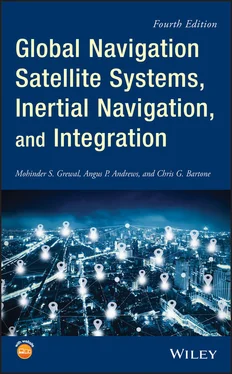The fully populated GPS constellation includes 31 active satellites with additional operational spares, in six operational planes. The satellites are in circular orbits with four or more satellites in each orbital plane. The orbital planes are each inclined at an angle of 55° relative to the equator and are separated from each other by multiples of 60° right ascension. Each satellite is in a medium Earth orbit (MEO), is nongeostationary, and is approximately circular, with radii of 26 560 km, with orbital period of one‐half sidereal day (≈11.967 hours). Four or more GPS satellites will always be visible from any point on the Earth's surface, where the GPS satellites can be used to determine an observer's position, velocity, and time (PVT) anywhere on the Earth's surface 24 h/d.
1.2.1.2 Legacy GPS Signals
Each GPS satellite carries a cesium and/or rubidium atomic clock (i.e. frequency reference oscillator) to provide timing information for the signals transmitted by the satellites. While each satellite carries several internal clock, all navigation signals are generated from one clock. Satellite clock corrections are provided to the users in the signals broadcast by each satellite, with the aid of the GPS Ground Control Segment. The legacy GPS satellite transmits two L‐band spread spectrum navigation signals on – an L1 signal with carrier frequency f 1= 1575.42 MHz and an L2 signal with carrier frequency f 2= 1227.6 MHz. These two frequencies are integral multiples f 1= 154 f 0and f 2= 120 f 0of a base frequency f 0= 10.23 MHz. The L1 signal from each satellite is binary phase‐shift keying (BPSK) modulated by two pseudorandom noise (PRN) codes in phase quadrature, designated as the C/A‐code and P(Y)‐code. The L2 signal from each satellite is BPSK modulated by only the P(Y)‐code. A brief description of the nature of these PRN codes follows, with greater detail given in Chapter 4.
Compensating for ionosphere propagation delays . The time delay from when a navigation signal is transmitted, to when the signal is received, is used to eventually estimate the distance between the satellite and the user. This signal propagation delay is affected by the atmosphere. As the signals pass through the ionosphere, the delay chances with frequency. This is one motivation for use of two different carrier signals, L1 and L2. Because delay through the ionosphere varies approximately as the inverse square of signal frequency f (delay ∝ f −2), the measurable differential delay between the two carrier frequencies can be used to compensate for the delay in each carrier (see Ref. [16] for details).
Code‐division multiplexing . Knowledge of the PRN codes allows users independent access to multiple GPS satellite signals on the same carrier frequency. The signal transmitted by a particular GPS signal can be selected by generating and matching, or correlating, the PRN code for that particular satellite. All PRN codes are known and are generated or stored in GPS satellite signal receivers. For legacy GPS there are two PRN codes transmitted from each satellite. The first PRN code from each GPS satellite, sometimes referred to as a precision code or P‐code , is a relatively long, fine‐grained code having an associated clock or chip rate of f 0= 10.23 MHz. A second PRN code from each GPS satellite, sometimes referred to as a clear or coarse acquisition code or C/A‐code , is intended to facilitate rapid satellite signal acquisition and handover to the P‐code. It is a relatively short, coarser‐grained code having an associated clock or chip rate of f 0= 1.023 MHz. The C/A‐code for any GPS satellite has a length of 1023 chips or time increments before it repeats. The full P‐code has a length of 259 days, during which each satellite transmits a unique portion of the full P‐code. The portion of P‐code used for a given GPS satellite has a length of precisely one week (seven days) before this code portion repeats. Accepted methods for generating the C/A‐code and P‐code were established by the satellite developer (Satellite Systems Division of Rockwell International Corporation) in 1991 [17].
Navigation signal . The GPS satellite bit stream includes navigational information on the ephemeris of the transmitting GPS satellite and an almanac for all GPS satellites, with parameters providing approximate corrections for ionospheric signal propagation delays suitable for single‐frequency receivers and for an offset time between satellite clock time and true GPS time. The legacy navigational information is transmitted at a rate of 50 baud. Further discussion of the GPS and techniques for obtaining position information from satellite signals can be found in chapter 4 of Ref. [18].
Precise positioning service ( PPS ) . Formal, proprietary service PPS is the full‐accuracy, single‐receiver GPS positioning service provided to the United States and its allied military organizations and other selected agencies. This service includes access to the encrypted P(Y)‐code.
Standard positioning service ( SPS ) . SPS provides GPS single‐receiver (stand‐alone) positioning service to any user on a continuous, worldwide basis. SPS is intended to provide access only to the C/A‐code and the L1 carrier.
1.2.1.3 Modernization of GPS
GPS IIF, GPS IIR–M, and GPS III provide the legacy and new modernized signals. These may include L2 civil (L2C) signal and the L5 signal (at 1176.45 MHz) modulated by a new code structure, as well as, the M and L1C codes. These modernized GPS signals improve the ionospheric delay calculation, ranging performance, ambiguity resolution, and overall PVT accuracy.
The GPS Ground Control Segment monitors the GPS signals in space, interfaces with the US Naval Observatory for timing information, and has remote monitor/uplink transmitter sites throughout the globe. Over the years, the GPS GCS has been upgraded and the Next‐Generation Operational Control System (OCX) will monitor all legacy and modernized GPS signals to provide for enhanced PVT solutions for the user segment. See Sections 4.2.8 and 10.5.5.5 and Ref. 18, Chapter 4.
1.2.2 Global Orbiting Navigation Satellite System (GLONASS)
A second system for global positioning is the Global Orbiting Navigation Satellite System (GLONASS), placed in orbit by the former Soviet Union and now operated and maintained by the Russian Republic [19,20].
GLONASS has 24 satellites, distributed approximately uniformly in three orbital planes (as opposed to six for GPS) of 8 satellites each. Each orbital plane has a nominal inclination of 64.8° relative to the equator, and the three orbital planes are separated from each other by multiples of 120° right ascension. GLONASS orbits have smaller radii than GPS orbits, about 25 510 km, and a satellite period of revolution of approximately 8/17 of a sidereal day.
The legacy GLONASS system uses frequency‐division multiplexing of independent satellite signals. Each GLONASS satellite transmits two navigation signals in the L1 and L2 frequency bands, corresponding to f 1= (1.602 + 9 k /16) GHz and f 2= (1.246 + 7 k /16) GHz, where k = −7, −6, … 5, 6 is the satellite number. These frequencies lie in two bands at 1.598–1.605 GHz (L1) and 1.242–1.248 GHz (L2). The L1 code is modulated by a C/A‐code (chip rate = 0.511 MHz) and by a P‐code (chip rate = 5.11 MHz). The L2 code is presently modulated only by the P‐code. The GLONASS satellites also transmit navigational data at a rate of 50 baud. Because the satellite frequencies are distinguishable from each other, the P‐code and the C/A‐code are the same for each satellite. The methods for receiving and analyzing GLONASS signals are similar to the methods used for GPS signals. Further details can be found in the patent by Janky [21].
Читать дальше












